
Étang Saumâtre, is the largest lake in Haiti It is also known as Lake Azuéi ; its Taíno name was Yainagua.

The Turks and Caicos rock iguana is a species of lizard endemic to the Turks and Caicos islands. This small iguana can reach 30 in (76 cm) and becomes mature at seven years and may live for twenty. A single clutch of up to nine eggs is laid each year, and these take three months to hatch. This iguana is mostly herbivorous, but supplements this by adding some animal matter to its diet.
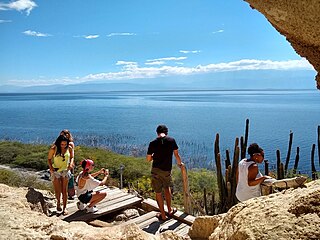
Lake Enriquillo is a hypersaline lake in the Dominican Republic located in the southwestern region of the country. Its waters are shared between the provinces of Bahoruco and Independencia, the latter of which borders Haiti. Lake Enriquillo is the largest lake in both the Dominican Republic and Hispaniola, as well as the entire Caribbean. It is also the lowest point for an island country.

The Mona ground iguana is a critically endangered species of rock iguana, endemic to Mona Island, Puerto Rico. It is one of the island nation's few large land animals, and it is the largest endemic terrestrial lizard in the country, and one of the biggest rock iguanas within the Antilles. It was previously considered a subspecies of the rhinoceros iguana.

The rhinoceros iguana is an endangered species of iguana that is endemic to the Caribbean island of Hispaniola and its surrounding islands. A large lizard, they vary in length from 60 to 136 centimetres, and skin colours range from a steely grey to a dark green and even brown. Their name derives from the bony-plated pseudo-horn or outgrowth which resembles the horn of a rhinoceros on the iguana's snout. It is known to coexist with the Ricord's iguana ; the two species are the only taxa of rock iguana to do so.

Cyclura ricordii, also known as Ricord's ground iguana or Ricord's rock iguana, is an endangered species of medium-sized rock iguana, a large herbivorous lizard. It is endemic to the island of Hispaniola. It is known to coexist with the nominate subspecies of the rhinoceros iguana ; the two species are the only taxa of rock iguana to do so. The natural habitats of its three subpopulations are hot, dry, wooded savanna on limestone with access to soil and sandy flats in southern Hispaniola. It is threatened by predation by introduced predators and habitat loss, due to overgrazing and charcoal manufacture.

Facheiroa cephaliomelana is a species of plant in the family Cactaceae.

Melocactus azureus is a species of cactus. It is endemic to Brazil, where it is known only from Bahia. It is locally abundant but the populations are fragmented and vulnerable to habitat degradation.
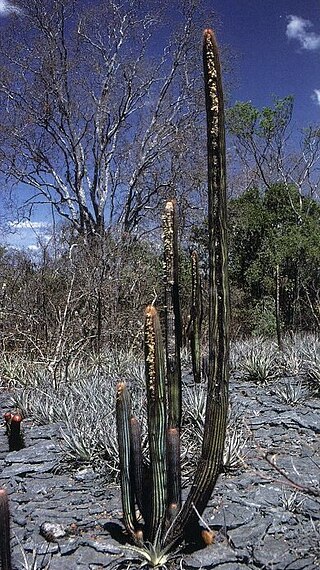
Micranthocereus dolichospermaticus is a species of plant in the family Cactaceae. It is endemic to Brazil, where it is confined to the states of Bahia and Minas Gerais. Its natural habitat is rocky areas. It is threatened by habitat loss.

Coccothrinax ekmanii, also known in Haitian Creole as gwenn or in Dominican Spanish as palma de guano, is an endangered species of palm which is endemic to the island of Hispaniola.

Buddleja domingensis, also known as the Hispaniolan butterfly bush, is a species endemic to the high mountain ranges in the Caribbean island of Hispaniola, growing in rocky, limestone ravines, along forest edges and roadsides.
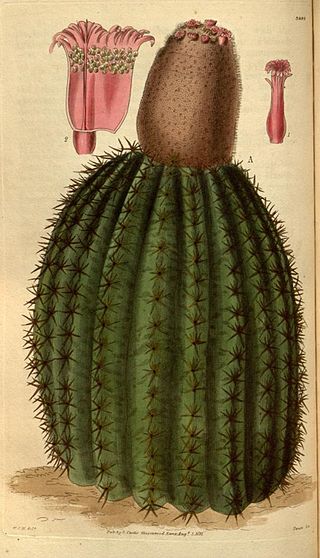
Melocactus intortus, also known as the Turk's head cactus, is a species of cactus endemic to the Caribbean.
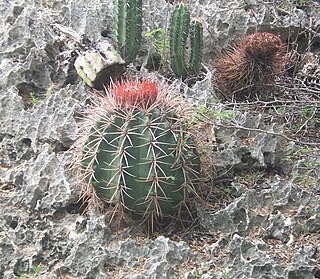
Melocactus caroli-linnaei is a cactus found in Jamaica. When mature it is columnar, up to 1 m (3.3 ft) high. Like all species of Melocactus, it forms a "cephalium" when mature – a dense mass of areoles covered with wool and spines at the tip of the stem. Flowers are produced only from the cephalium.

Thelocactus hexaedrophorus is a species of cactus. It is endemic to Mexico.
The Hispaniola racer or Hispaniolan brown racer is a snake that is endemic to the Caribbean island of Hispaniola. It is monotypic in the genus Haitiophis.

The Hispaniolan dry forests are a tropical dry broadleaf forest ecoregion on the island of Hispaniola. They cover 15,123 km2 (5,839 sq mi), around 20% of the island's area.

The Enriquillo wetlands are a flooded grasslands and savannas ecoregion on the island of Hispaniola. They cover about 628 km2 (242 sq mi) around several low-lying lakes in southwestern Hispaniola in both the Dominican Republic and Haiti.

Melocactus neryi is a species of flowering plant from the genus Melocactus.
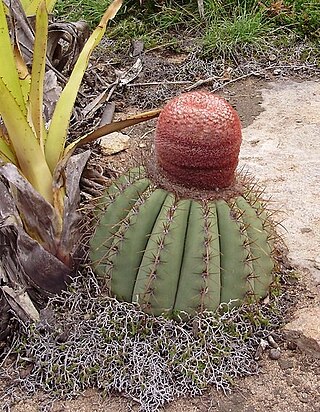
Melocactus ernesti is one of the Turk's cap cacti, and is native to Bahia and Minas Gerais States, Brazil.

Melocactus bahiensis is a species of Melocactus found in Bahia, Brazil.





















